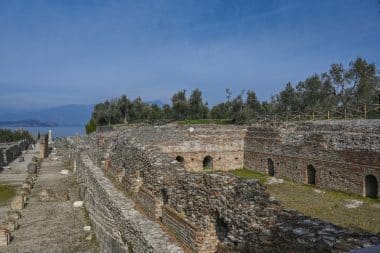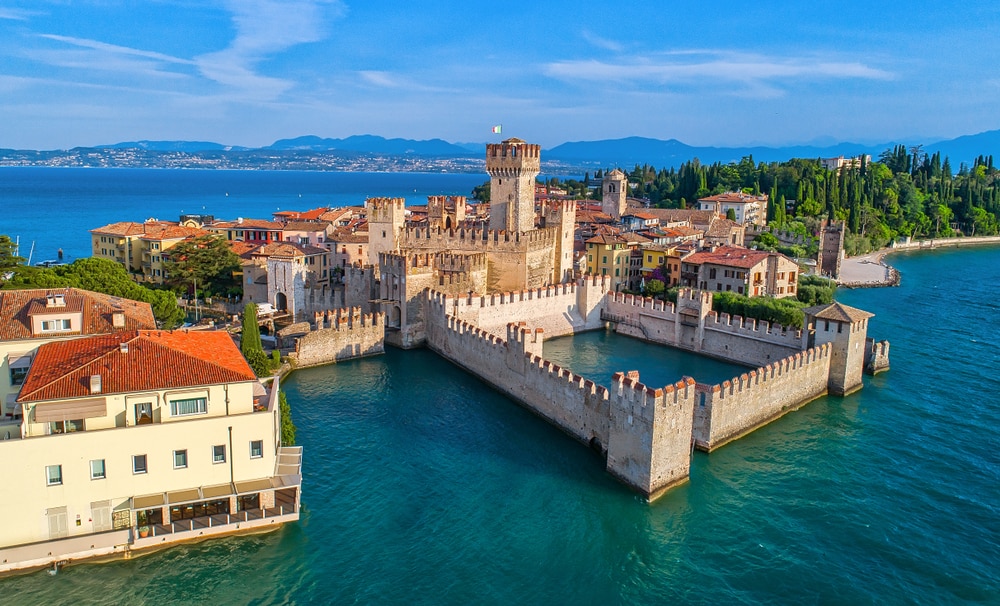The charming town of Sirmione on Lake Garda is as spectacular as it is romantic. Sirmione on Lake Garda, with a population of around 8,400, is located on an elongated promontory that juts deep into Lake Garda. Just to experience this breathtaking ambience, a quintessentially Italian city with winding alleys and unique buildings, nestled between the soft blue of Lake Garda, is worth the journey. But Sirmione on Lake Garda has even more to offer. Here you can enjoy a wonderful cure in healing water. And on Lake Garda you can really relax, explore old walls and museums or experience the dolce vita in one of the many restaurants.
A visit to the Scaliger Castle
There is a lot to discover in Sirmione on Lake Garda. Visually, the first thing that catches everyone’s eye here is the Scaliger Castle. This is a moated castle that was built as early as the 14th century. Once it served primarily to defend the city, but due to its imposing construction, it also radiated a certain position of power that could keep potential attackers away from the outset. The fortification, surrounded by a moat and equipped with a drawbridge and three towers, has been well preserved. In addition, the Scaliger castle has its own small harbor. If you want, you can visit the small museum of the fortification.
The Caves of Catullus

In the Grottoes of Catullus , visitors immerse themselves in ancient Rome of the first century AD. The Grottoes of Catullus have little to do with a cave, even if one might suspect so from the name. Rather, you can visit the remains of a Roman villa, which probably served as a sanatorium with an integrated thermal bath. And the villa was huge. 20,000 square meters of space were used on three floors. Among other things, there were bathing facilities, guest rooms and verandas with panoramic terraces, which even then offered the residents a spectacular view over the turquoise shimmering Lake Garda. It is believed that the Grottoes of Catullus collapsed in the fourth or fifth century AD and were then abandoned. In the Caves of Catullus there is a small museum where interesting archaeological finds are exhibited. By the way, a visit to the area can be easily combined with a seaside resort, because only a few steps away from the Roman villa there is a quiet bathing area that can only be reached on foot.
Sirmione on Lake Garda as a health resort
Sirmione on Lake Garda is not only colloquially considered a health resort, the city is also officially so. In the city there are abundant deposits of thermal water, which has a high content of iodine, bromine and sulfur. The Romans already cured here, as the existence of the Grottoes of Catullus proves. The local thermal water is said to have positive effects on heart, circulatory and respiratory diseases. It is also said to cure skin conditions excellently. The thermal water comes from the source of Monte Baldo. There are several therapy centers and spas in the city that use the healing waters. A particularly large number of visitors come to the Terme di Catullo, which was already in operation at the end of the 19th century.
Sirmione on Lake Garda and the Dolce Vita

Hardly any other town on Lake Garda is better suited than Sirmione to soak up the real Italian feeling of the Dolce Vita. If you plan to do this, you should start with a walk through the car-free old town of the town. The Corso Vittorio Emanuele is a good starting point, from which you can walk along Piazza Carducci and discover the town centre with its romantic houses. The alleys in the old town are narrow and a little winding. Here and also on the lakeshore, after a long walk, you will find the opportunity to really unwind in a rustic Italian bar or a traditional restaurant. After all, fresh fish, pasta, pizza, tiramisu, ice cream, wine and espresso taste particularly good with a view of the lake.
Marvel at the churches and chapels of Sirmione
The small village has numerous chapels and church buildings worth seeing. The church of San Pietro in Mavino is very idyllic on a hill away from the center, which impresses above all with its artistically applied frescoes. If you are on your way to the Grottoes of Catullus, you should stop here, but be careful, because the church is hidden between olive and cypress trees, so that many a tourist could not find it. The rather flat Romanesque church was built as early as the eighth century, the frescoes mostly date from the 14th and 16th centuries.
The small chapel of Sant’Anna della Rocca is also well worth seeing. It has been located opposite the Scaliger Castle since the 14th century. Since then, the chapel has been rebuilt several times and every change has left its mark. The building has an interesting cross vault and pretty frescoes, but also stained glass from the 20th century.
If you don’t shy away from a short walk, you can’t miss a visit to the parish church of Santa Maria Maggiore. Santa Maria Maggiore is located on a hill a little away from the center. The building dates back to the 15th century. Santa Maria Maggiore is best known for its massive-looking marble altar, which forms the undisputed centre of the church – also visually. Anyone who wants to hear the church’s organ, which dates back to the 18th century, should come to the service times. There are also excellently crafted wood carvings and frescoes to visit.


